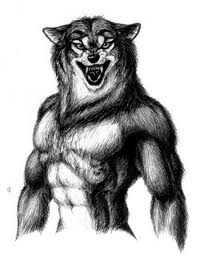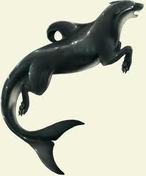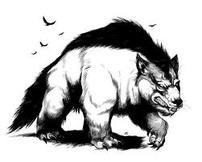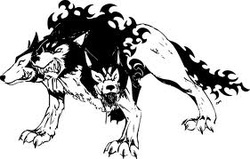Mythical Dogs and Wolfs
ADLET
The Adlet (or Erqigdlet) in the Inuit mythology of Greenland and the Labrador and Hudson Bay coasts, are a race of fabulous creatures. While the word refers to inland native American tribes, it also denotes a tribe with dogs' legs and human bodies. The lower part of the body of the canine Adlet is like that of a dog, their upper part is like a man's. All Adlet run very fast, and usually encounters between men and adlet end up in battle, usually with man as the victor.
In Inuit lore, they are often portrayed as in conflict with humans, and are supposed to be taller than Inuit and white people. In some stories they are cannibals. Inuit from Labrador use the term Adlet, tribes west of the Hudson Bay use the word Erqigdlit. The monstrous race begotten by the Adlet was identified with inland native Americans by the Labrador and Hudson Bay tribes; Inuit from Greenland and Baffin Land, which had no native American neighbors, use the term to refer to the half human, half canine creatures. An etymology of the word is proposed by H. Newell Wardle: adlet might come from ad, "below," and thus denote "those below." Alternatively, he argues, it might come from the stem agdlak, "striped, streaked," thus "the striped ones," in reference to American Indians who lived to the west and painted their faces. "Erqigdlet" might be a derogatory term denoting the same people.Atlat means "others," denoting American Indians from the Inuit perspective, though Newell Wardle considers this possibility secondary and deriving from phonetic similarity. |
OriginFranz Boas, an ethnologist who recorded many Inuit stories, gives an account of the origin of the Adlet; he had heard the story in Baffin Land, specifically in Cumberland Sound from an Inuit named Pakaq. His transcription, a translation by H. Rink, and an explanation (by Boas) were published in The Journal of American Folklore in 1889. The Inuit of Greenland, according to Rink, tell the same story as those in Baffin Land.[10] The story is often referred to as "The Girl and the Dogs" on the west coast of Greenland; on the east coast of Greenland it is known as "The Origin of the Qavdlunait and Irqigdlit" (that is, Europeans and Indians).
A woman, Niviarsiang ("the girl"), lives with her father, Savirqong, but will not marry, and hence is also called Uinigumissuitung ("she who wouldn't take a husband"). After rejecting all her suitors, she marries a dog, Ijirqang, with white and red spots. Of their ten children, five are dogs and the others are Adlet, with dog's bodies for their lower half and man's bodies for their upper half. Since Ijirqang does not go hunting and the children are very hungry, it falls to Savirqong to provide for the noisy household. At last he puts them into a boat and carries them off to a small island, telling Ijirqang to come and get meat daily. Niviarsiang hangs a pair of boots around his neck and he swims ashore, but Savirqong, instead of giving him meat, puts stones in the boots and Ijirqang drowns. In revenge, Niviarsiang sends the young dogs over to gnaw off her father's feet and hands. He, in return kicks her overboard when she happens to be in his boat, and when she hangs on the gunwhale he cuts off her fingers, which, when they fall in the ocean, turn into whales and seals. Since Niviarsiang is scared her father might kill the Adlet, she sends them inland, and from them a numerous people springs. The young dogs she sends across the ocean in a makeshift boat, and arriving beyond the sea they became the Europeans' ancestors. |
AKHLUT

In Inuit mythology, Akhlut is a spirit that takes the form of both a wolf and an orca. It is a vicious, dangerous beast. Its tracks can be recognized because they are wolf tracks that lead to and from the ocean. Often, dogs seen walking to the ocean and/or into it are considered evil. Little is known of this spirit, other than that it changes from an orca to a wolf when hungry, not many myths relate to it.
AMAROK

Amarok (or Amaroq) is the name of a gigantic wolf in Inuit mythology.
It is said to hunt down and devour anyone foolish enough to hunt alone at night. Unlike real wolves who hunt in packs, Amarok hunts alone. It is sometimes considered equivalent to the waheelaof cryptozoology. See also Amaguq; a trickster and wolf god.
It is said to hunt down and devour anyone foolish enough to hunt alone at night. Unlike real wolves who hunt in packs, Amarok hunts alone. It is sometimes considered equivalent to the waheelaof cryptozoology. See also Amaguq; a trickster and wolf god.
CERBERUS
Cerberus ( /ˈsɜrbərəs/), or Kerberos, (Greek form: Κέρβερος, [ˈkerberos]) in Greek and Roman mythology, is a multi-headed hound (usually three-headed) which guards the gates of the Underworld, to prevent those who have crossed the river Styx from ever escaping. Cerberus featured in many works of ancient Greek and Roman literature and in works of both ancient and modern art and architecture, although the depiction and background surrounding Cerberus often differed across various works by different authors of the era. The most notable difference is the number of its heads: Most sources describe or depict three heads; others show it with two or even just one; a smaller number of sources show a variable number, sometimes as many as 50 or even 100.
|
MythologyCerberus was the offspring of Echidna, a hybrid half-woman and half-serpent, and Typhon, a fire-breathing giant whom even the Greek gods feared. Its brother is Orthrus, always depicted as a two-headed hellhound. The common depiction of Cerberus in Greek mythology and art is as having three heads. In most works the three-heads each respectively see and represent the past, the present, and the future, while other sources suggest the heads represent birth, youth, and old age. Each of Cerberus' heads is said to have an appetite only for live meat and thus allow only the spirits of the dead to freely enter the underworld, but allow none to leave. Cerberus was always employed as Hades' loyal watchdog, and guarded the gates that granted access and exit to the underworld .
|
